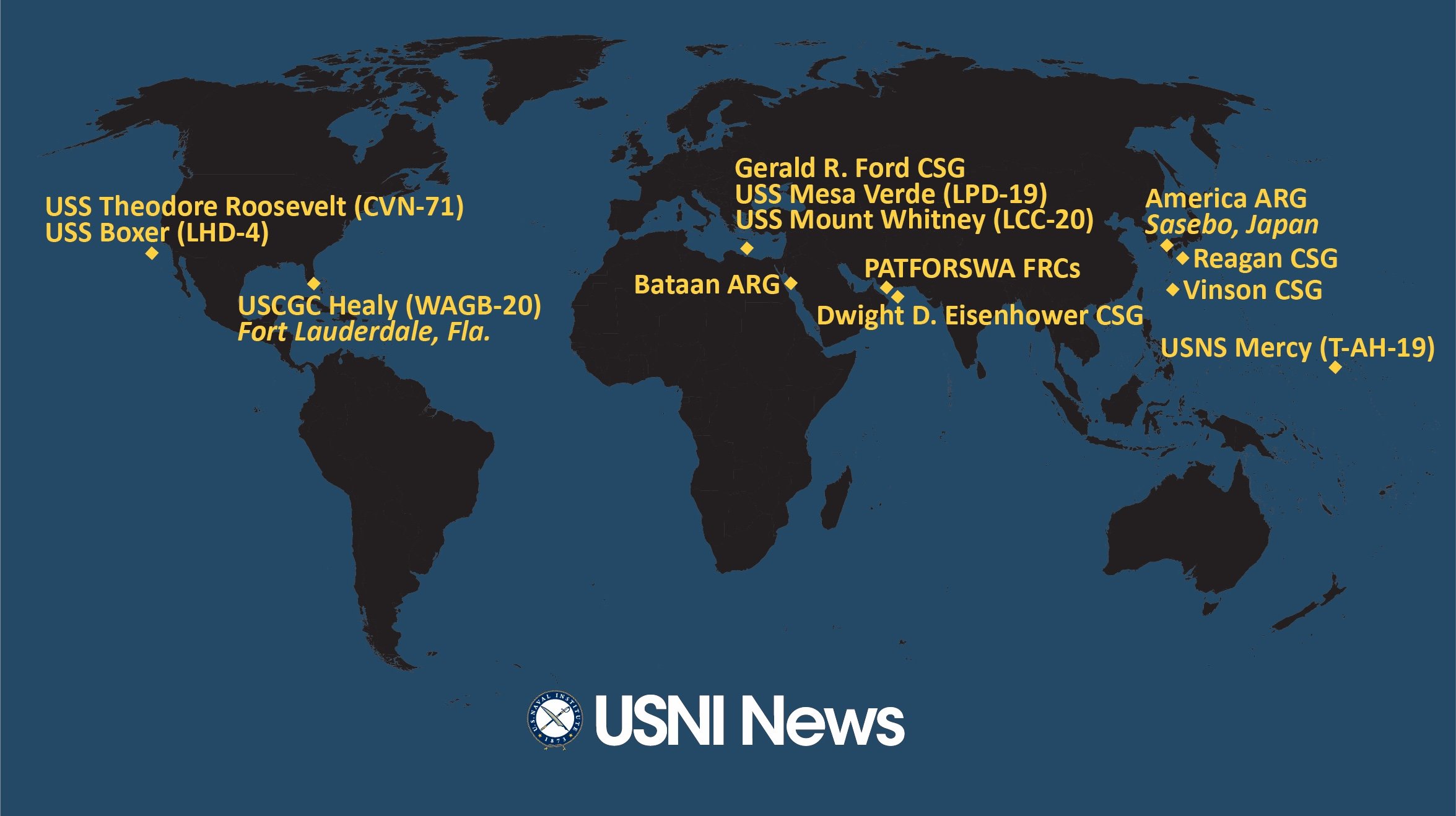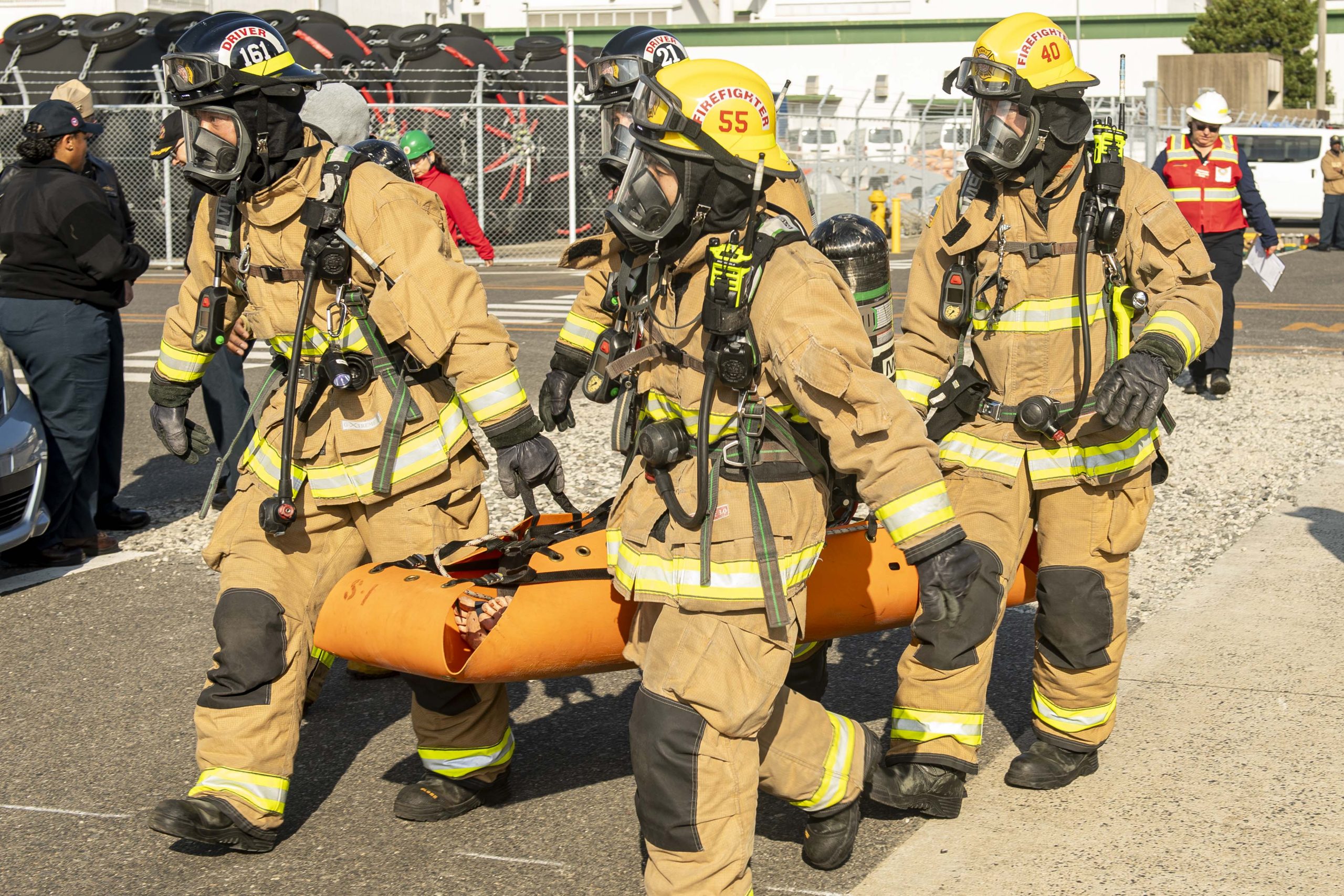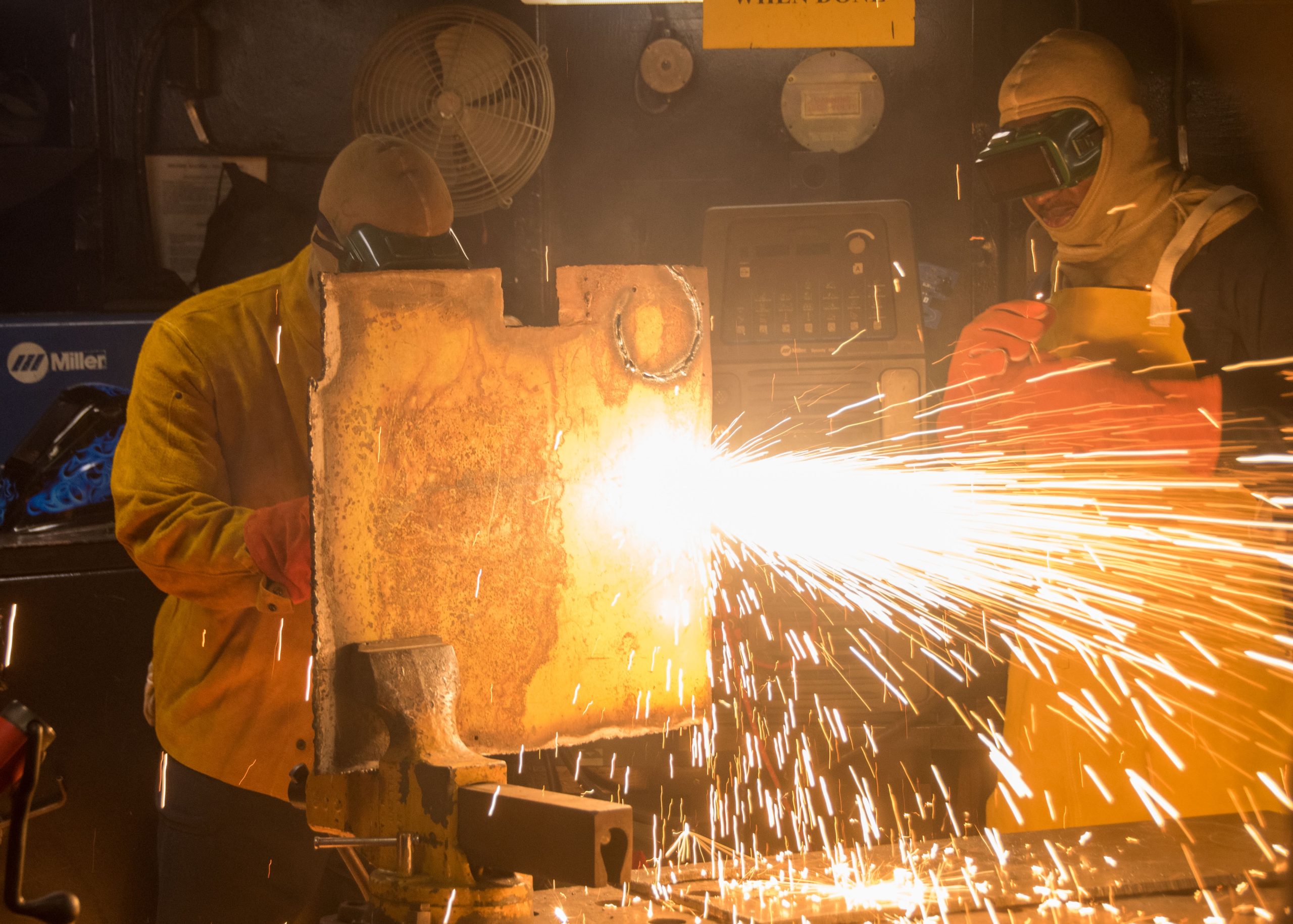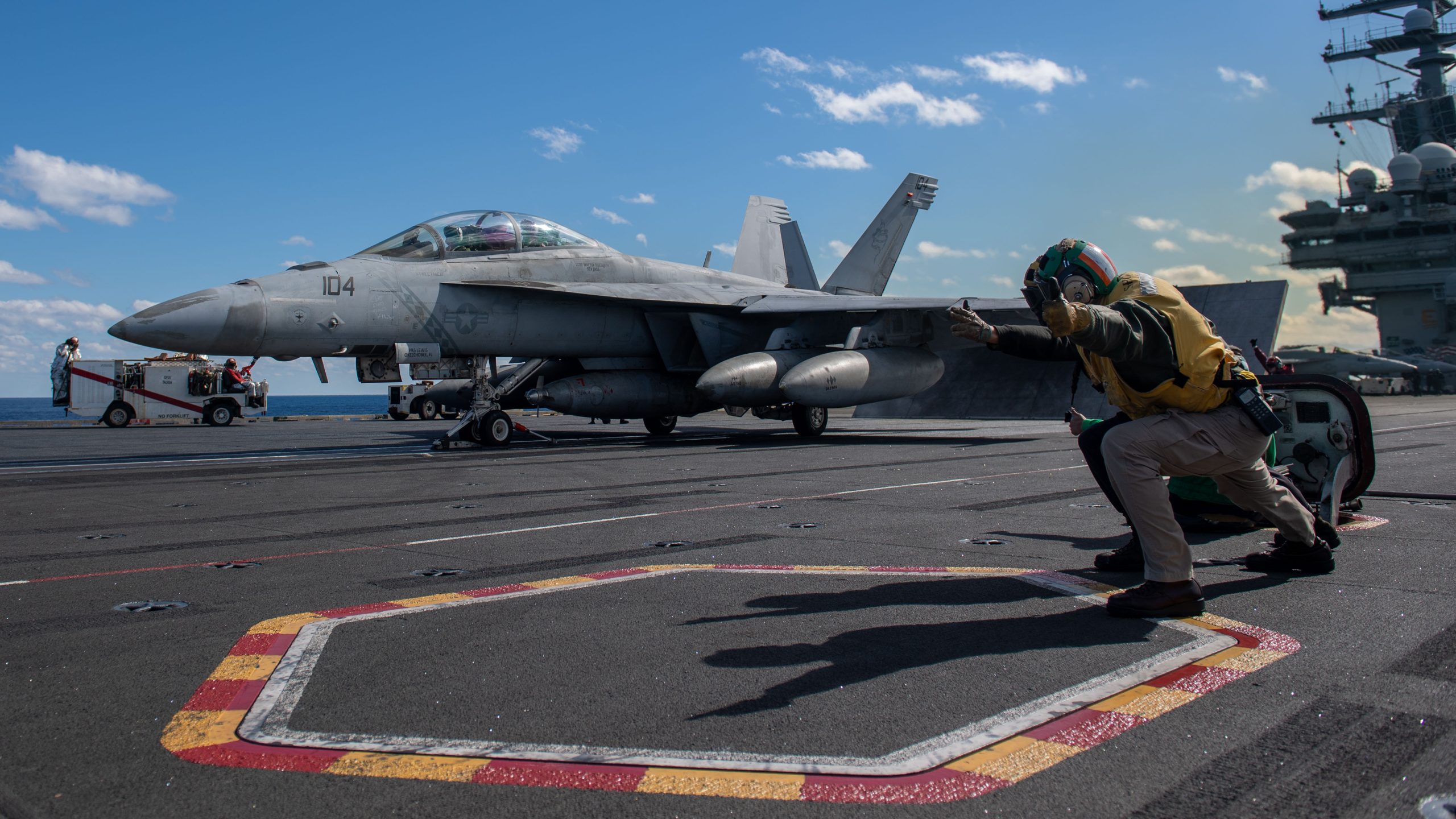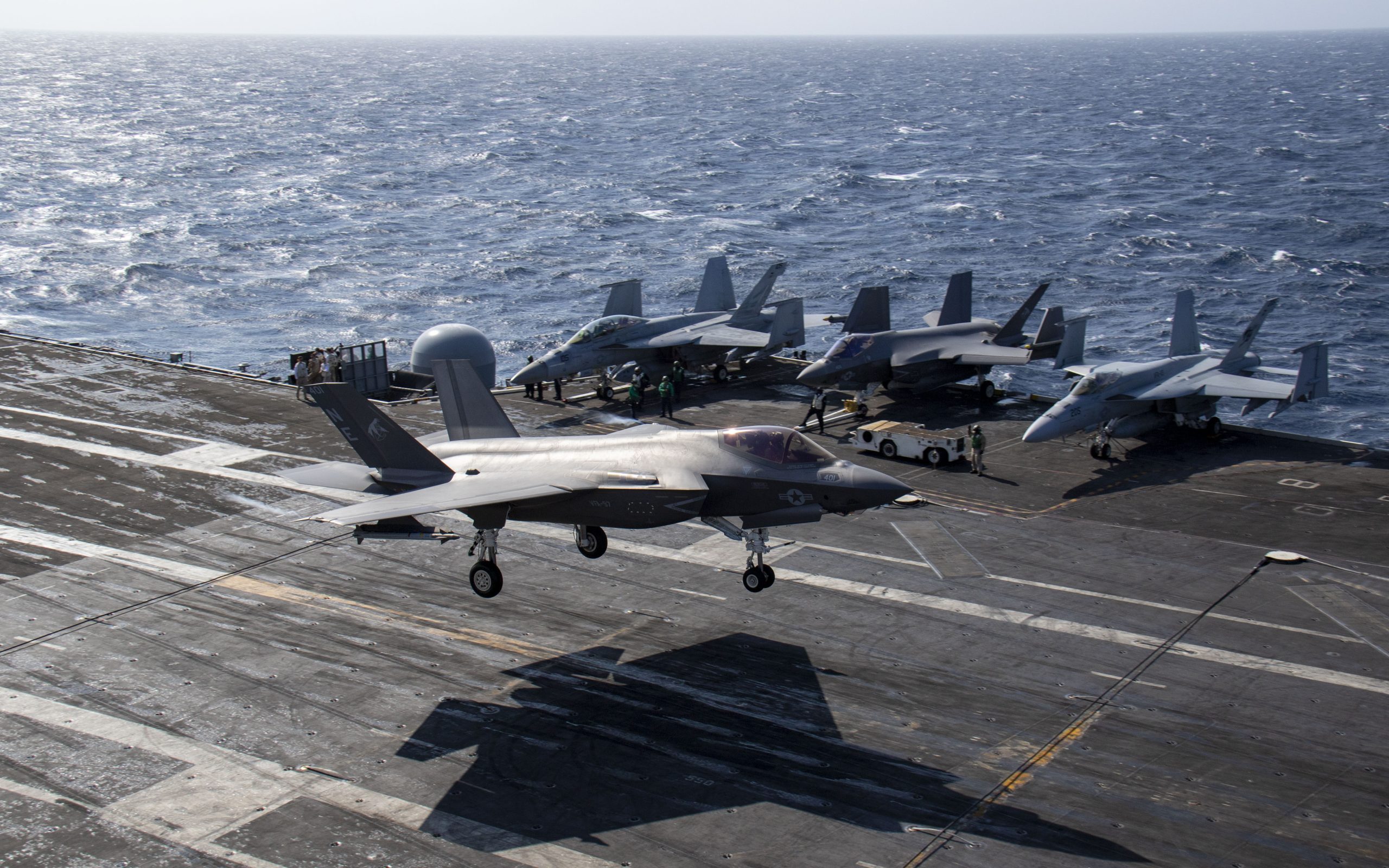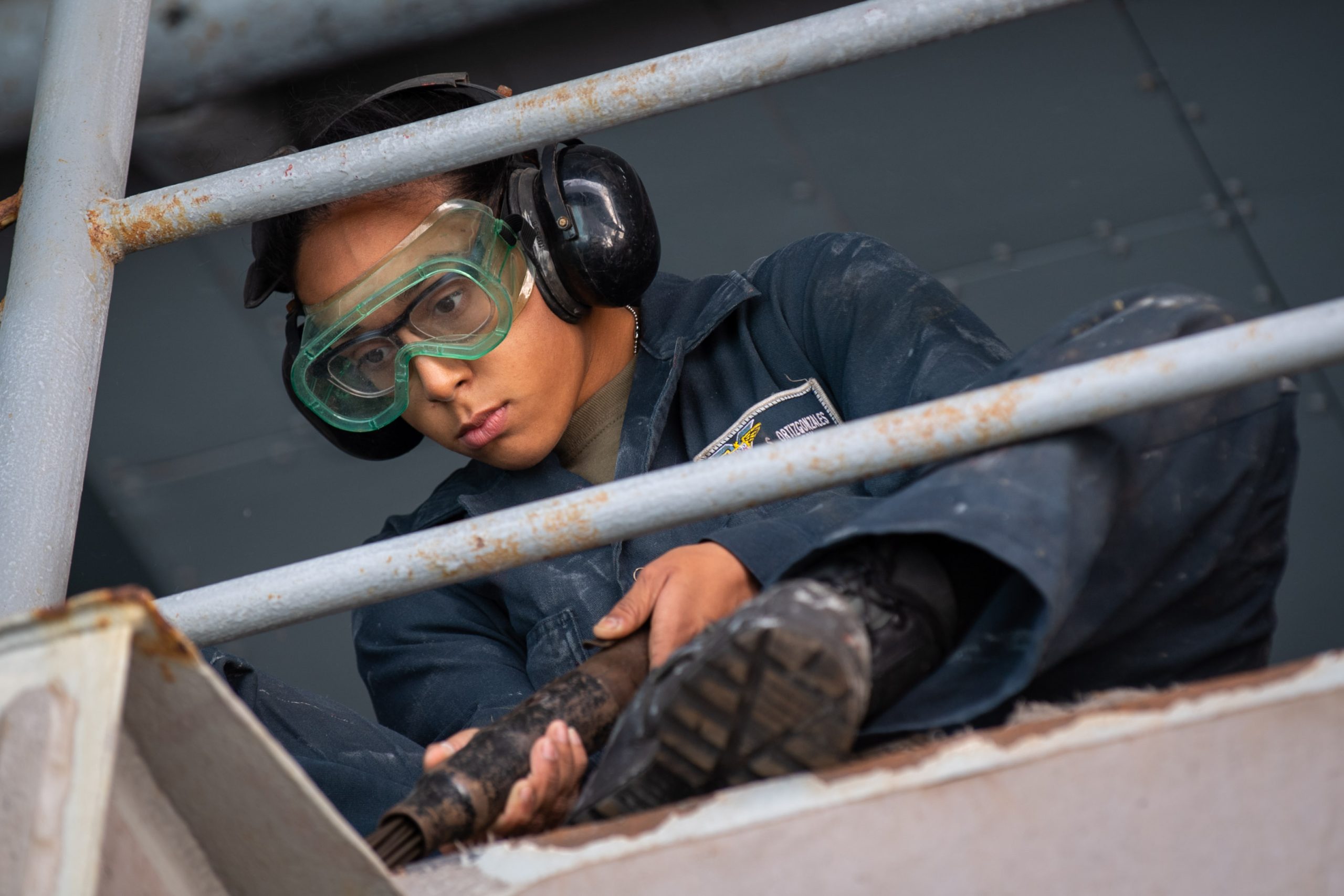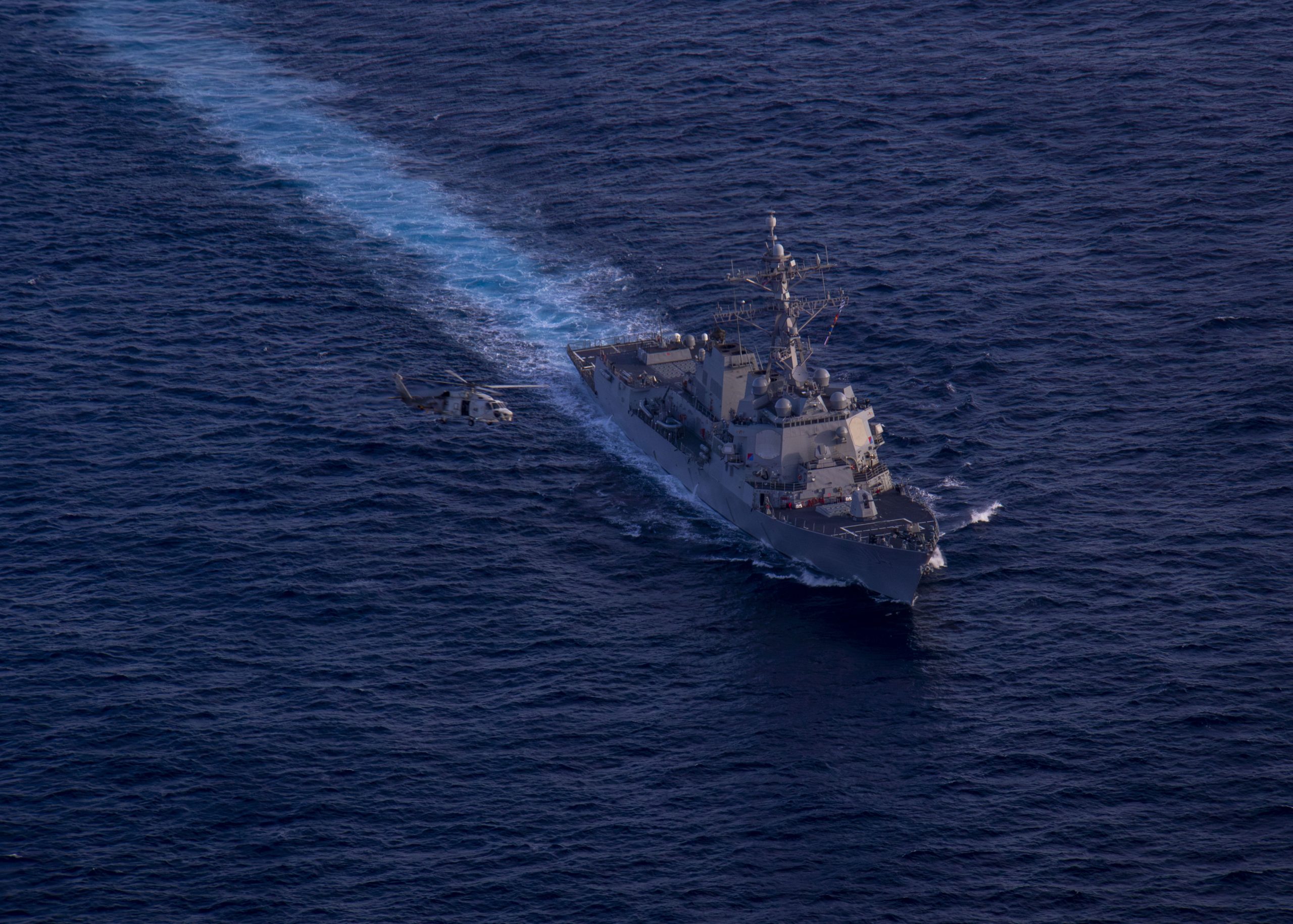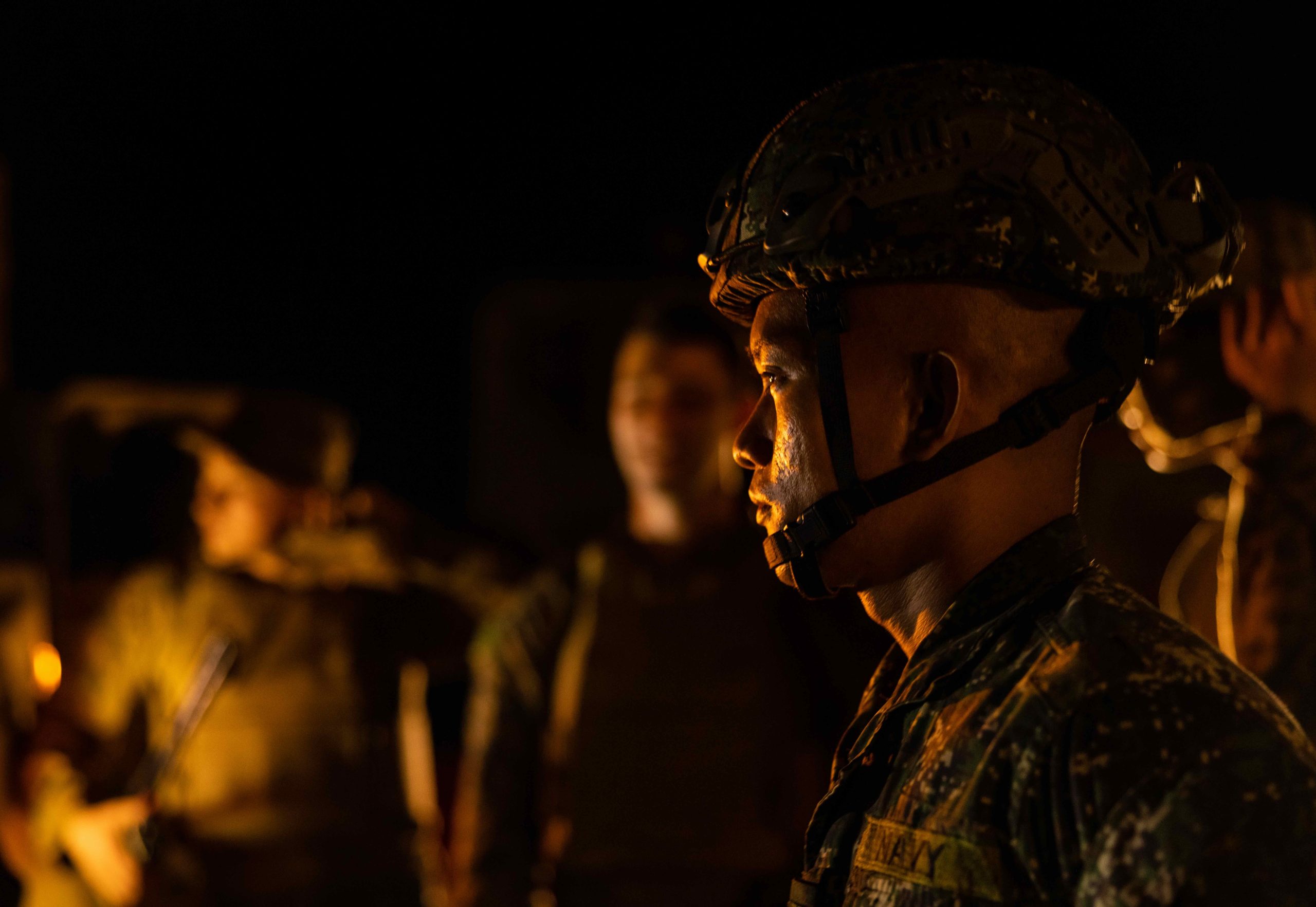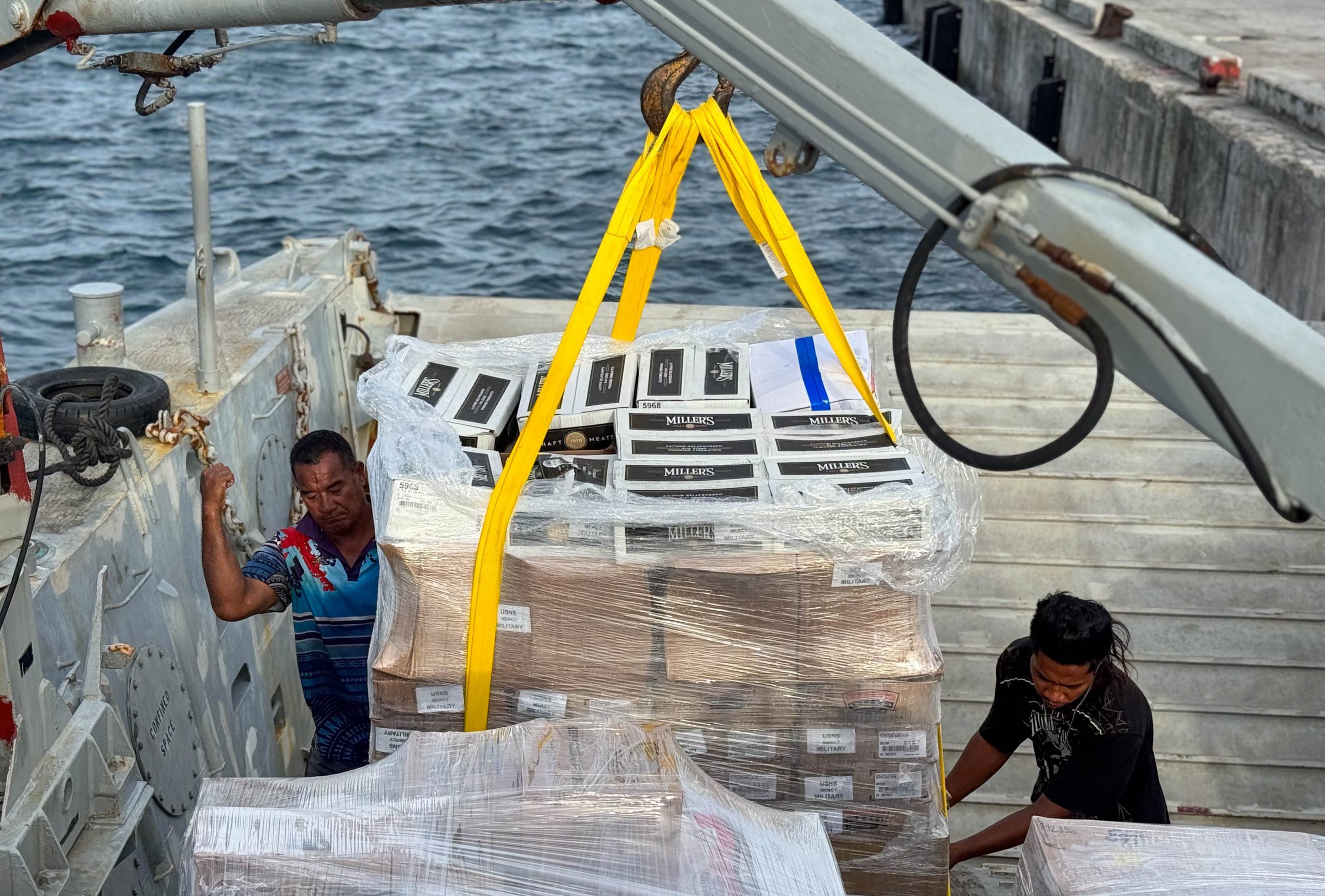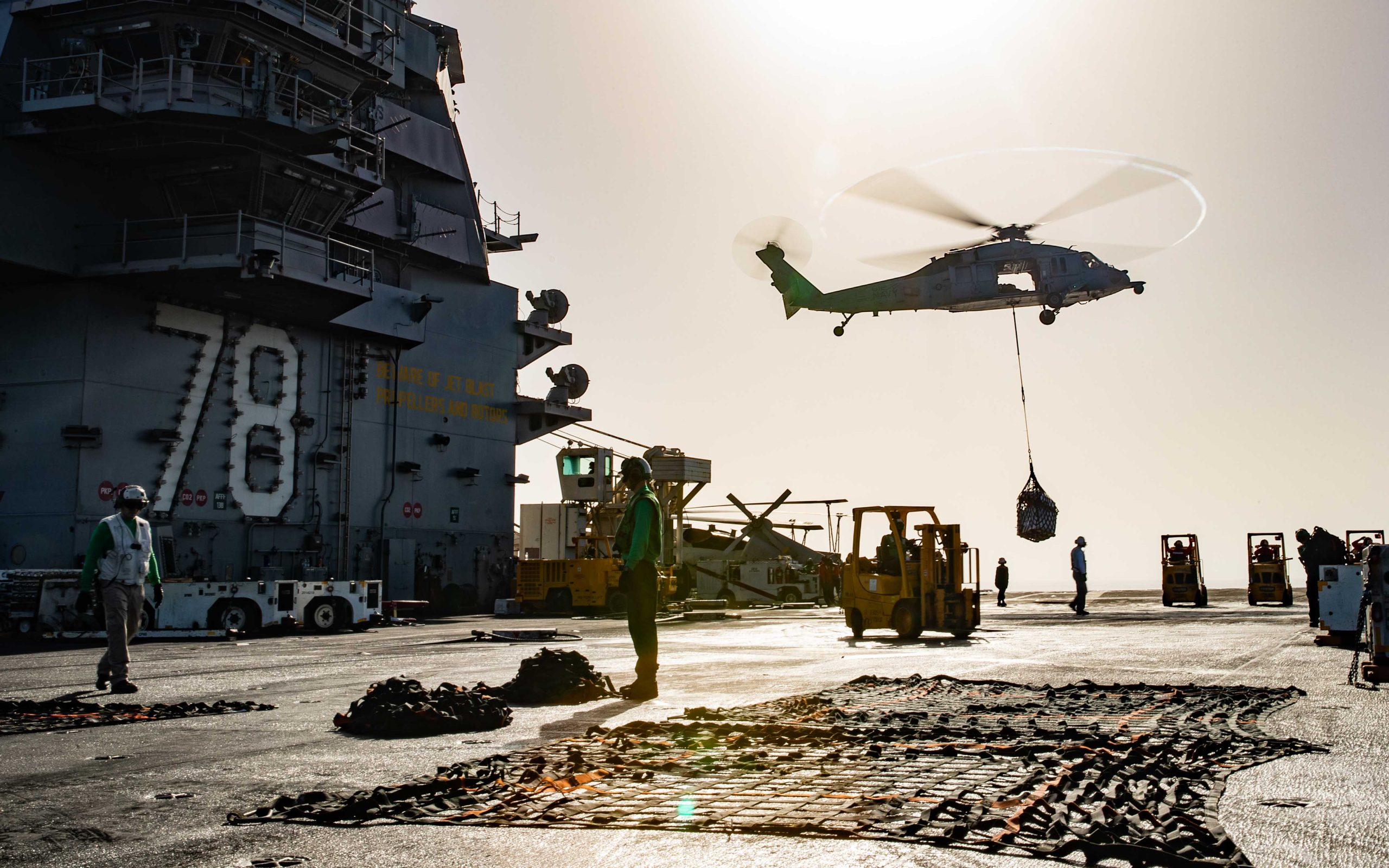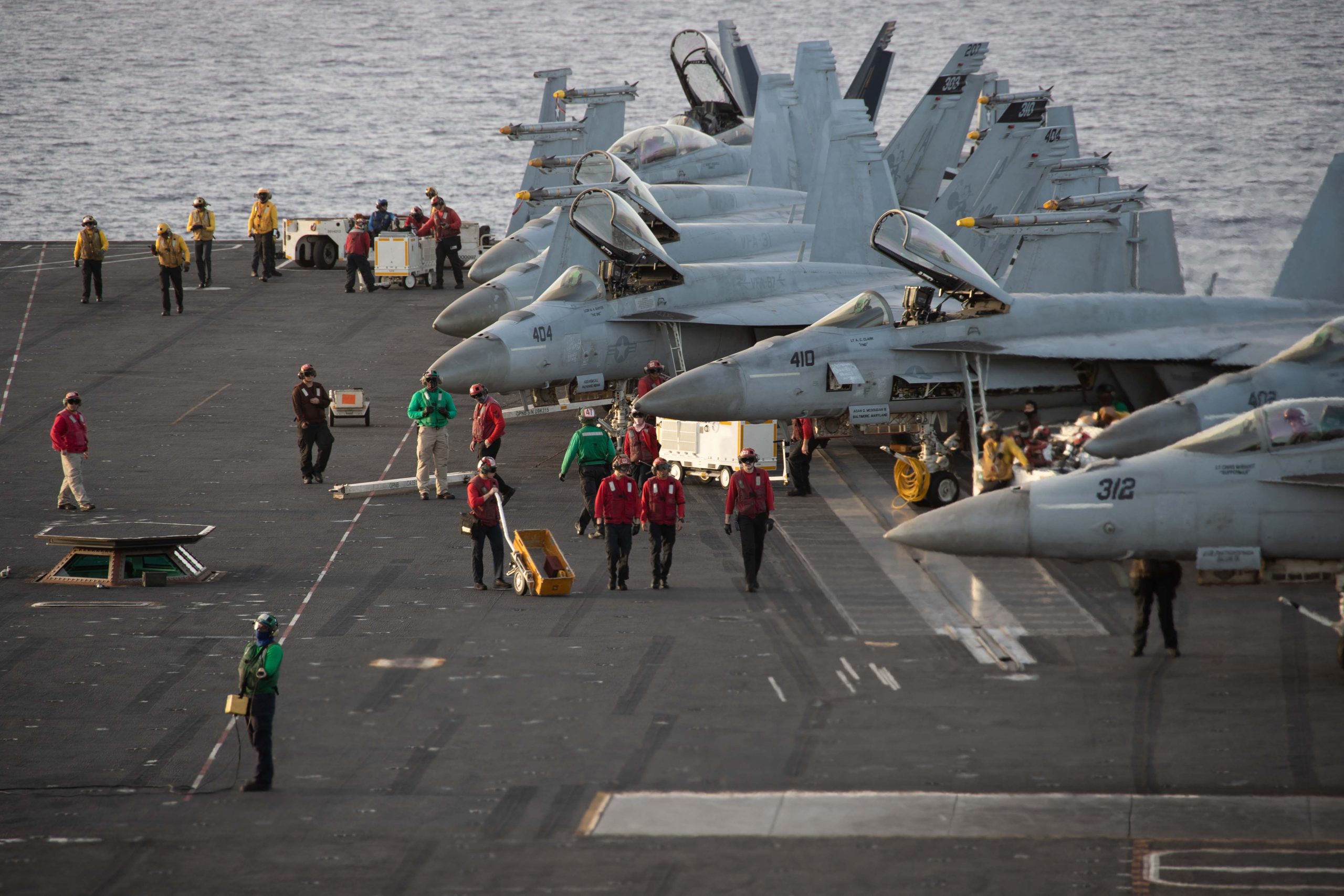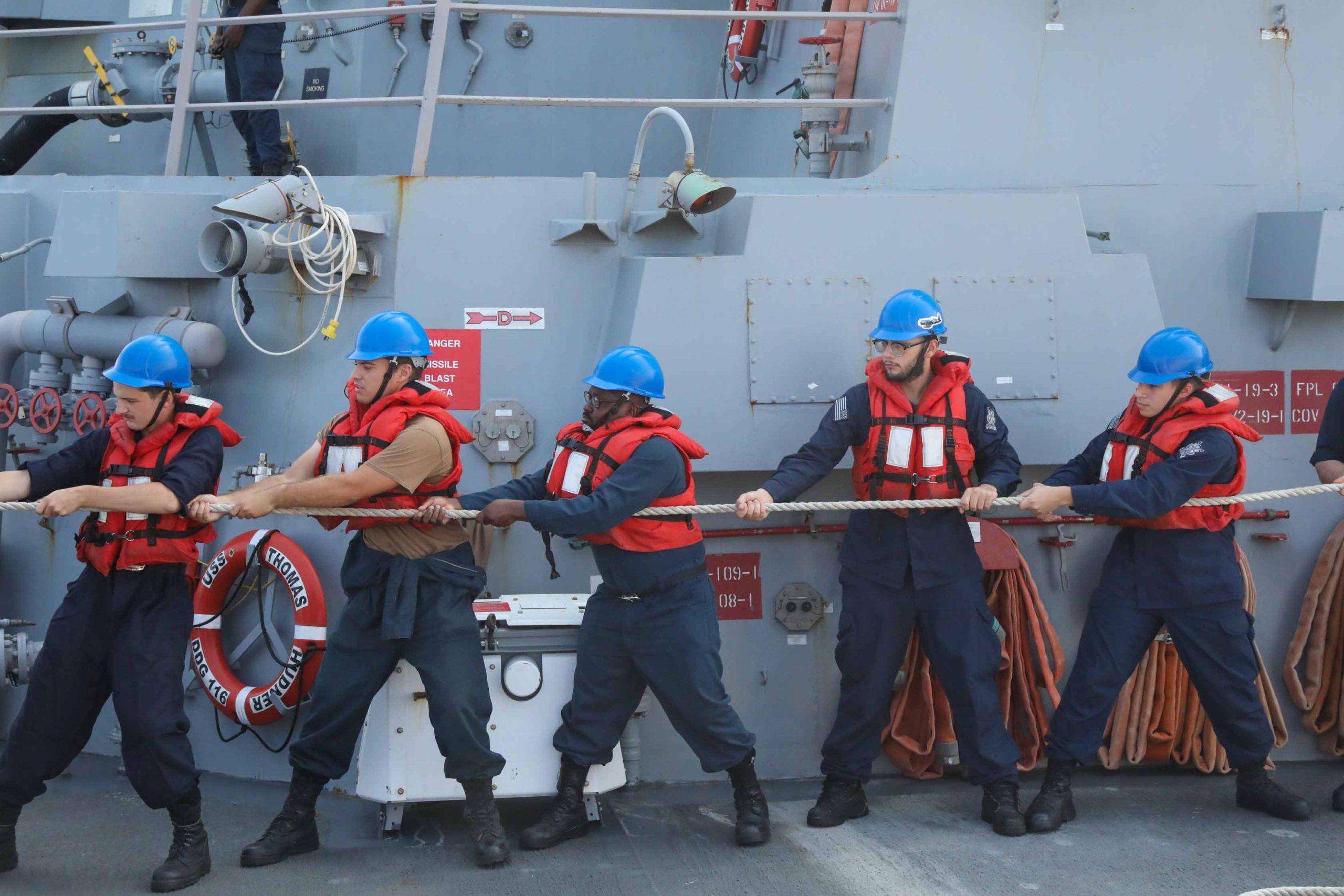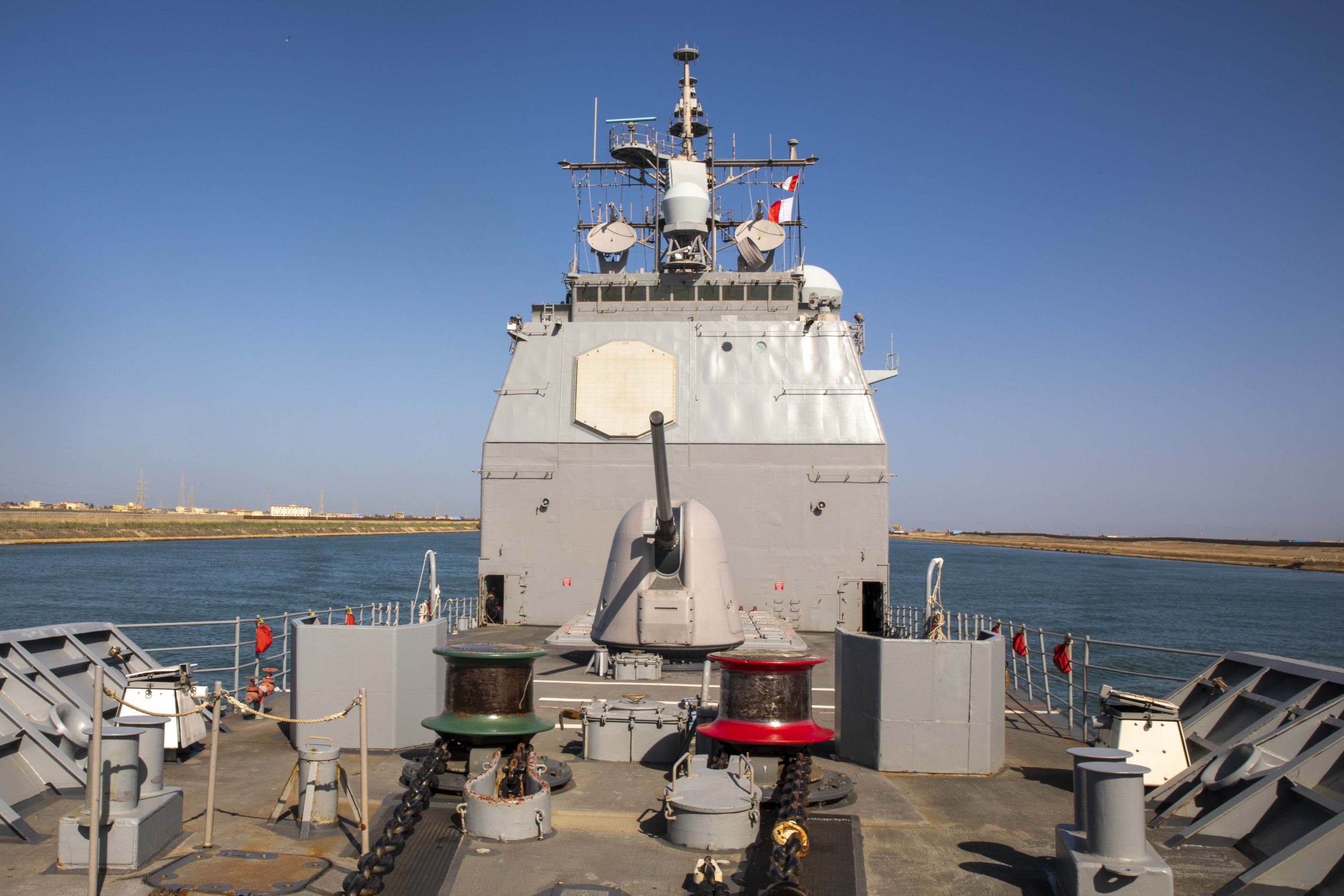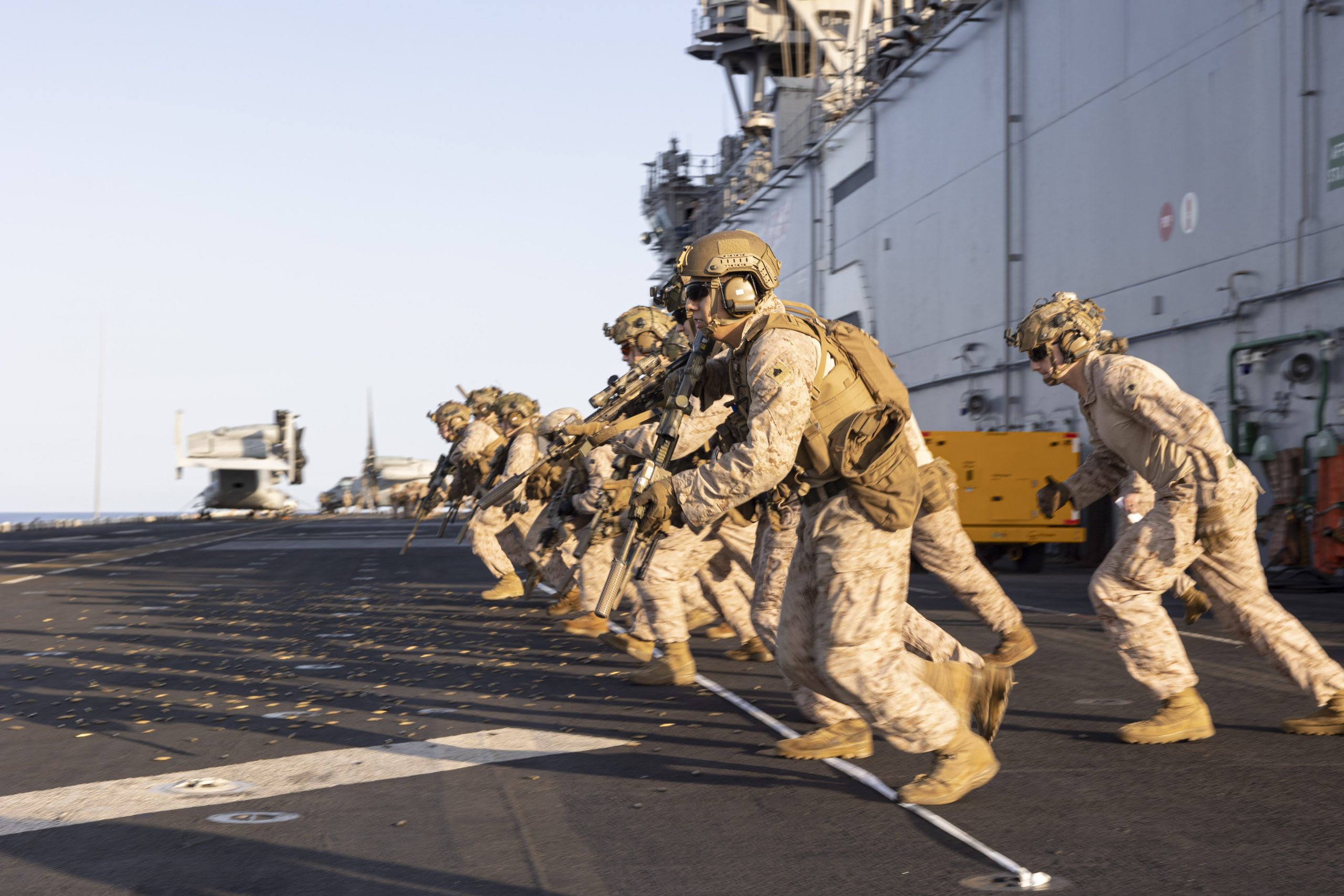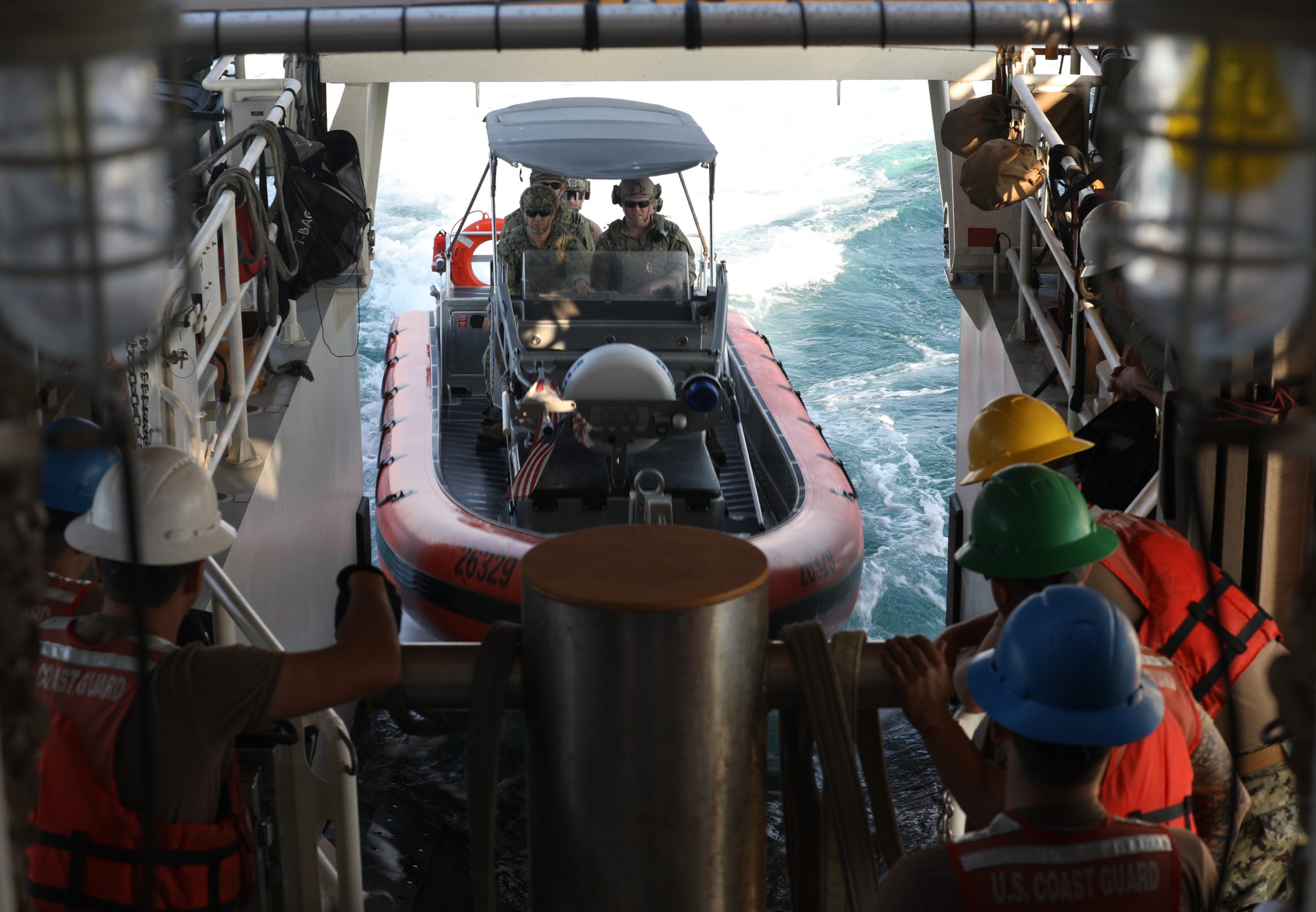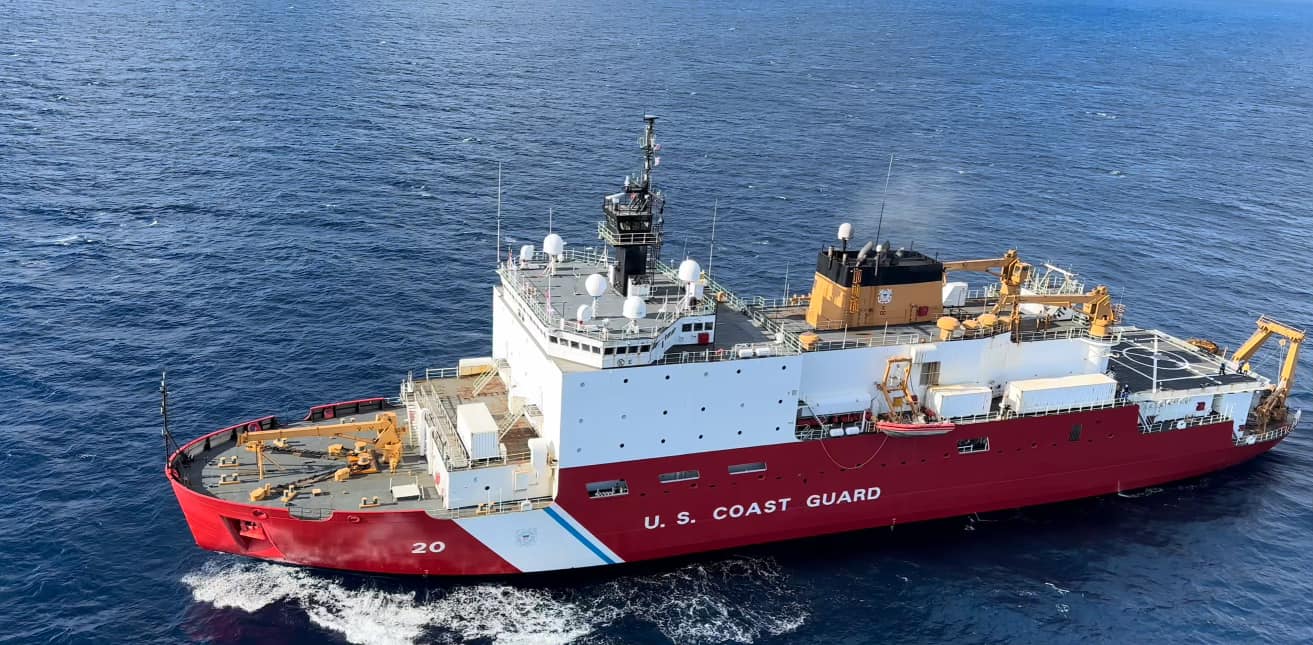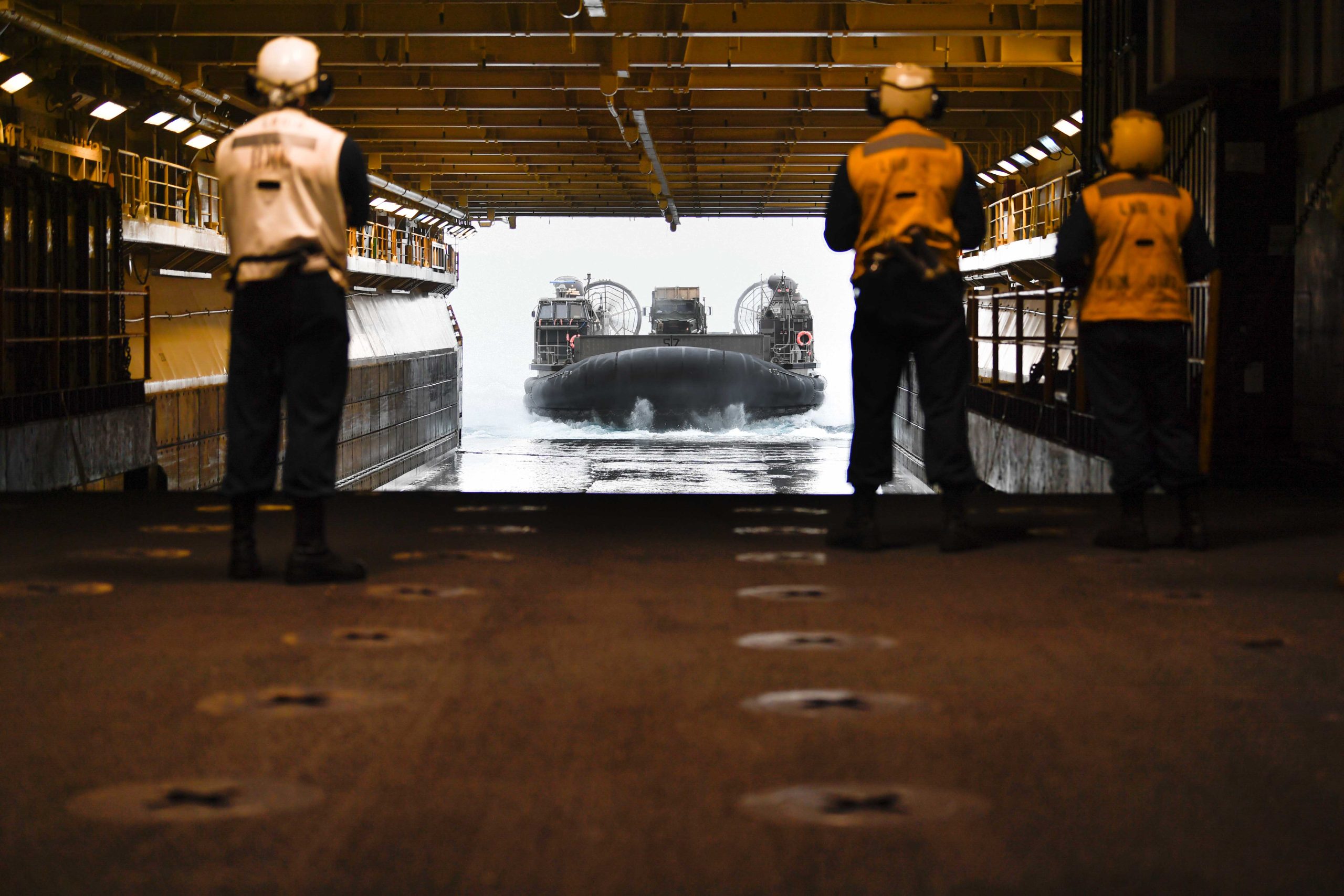These are the approximate positions of the U.S. Navy’s deployed carrier strike groups and amphibious ready groups throughout the world as of Nov. 16, 2023, based on Navy and public data. In cases where a CSG or ARG is conducting disaggregated operations, the chart reflects the location of the capital ship. This post has been updated to include more information on deployed and underway ships.
Ships Underway
| Total Battle Force |
Deployed |
Underway |
291
(USS 232, USNS 59) |
106
(USS 73, USNS 33) |
85
(55 Deployed, 30 Local) |
In Sasebo, Japan

Firefighters from Commander Navy Region Japan (CNRJ) Fire and Emergency Services Sasebo fire department transport a rescue mannequin with simulated injuries on a stretcher during a major shipboard fire drill aboard the amphibious transport dock ship USS New Orleans (LPD-18) at Commander, Fleet Activities Sasebo (CFAS) Nov. 15, 2023. US Navy Photo
USS America (LHA-6) is in Sasebo, Japan, according to ship spotters.
In the Philippine Sea

Aviation Structural Mechanic 2nd Class Noah Hurtado, left, from Miami, and Aviation Support Equipment Technician 2nd Class Adeboye Olunuga, from Jacksonville, Fla., use a portable exothermic cutting unit in the metalsmith shop during the damage control (DC) Olympics aboard USS Ronald Reagan (CVN-76), in the Philippine Sea, Nov. 13, 2023. US Navy Photo
The Reagan Carrier Strike Group (CSG) is underway in the Philippine Sea.
Carrier Strike Group 5

Electronics Technician 3rd Class Marlon Pacheco, from Gilford, N.H., assembles a radio in the portable communications repair lab aboard USS Ronald Reagan (CVN-76), in the North Pacific Ocean, Nov. 15, 2023. US Navy Photo
Aircraft Carrier
USS Ronald Reagan (CVN-76), homeported in Yokosuka, Japan.
Carrier Air Wing 5

Lt. Cmdr. Lyle Tomaszewski, from Milan, Mich., signals the launch F/A-18F Super Hornet, attached to the ‘Diamondbacks’ of Strike Fighter Squadron (VFA) 102, on the flight deck of USS Ronald Reagan (CVN-76), in the Philippine Sea on Nov. 14, 2023. US Navy Photo
Carrier Air Wing (CVW) 5, based at Marine Corps Air Station Iwakuni, Japan, is embarked aboard Ronald Reagan and includes a total of nine squadrons and detachments:
- The “Royal Maces” of Strike Fighter Squadron (VFA) 27 – from Marine Corps Air Station Iwakuni, Japan.
- The “Diamondbacks” of VFA-102 from MCAS Iwakuni.
- The “Eagles” of VFA-115 from MCAS Iwakuni.
- The “Dambusters” of VFA-195 from MCAS Iwakuni.
- The “Shadowhawks” of Electronic Attack Squadron (VAQ) 141 – from MCAS Iwakuni.
- The “Tiger Tails” of Carrier Airborne Early Warning Squadron (VAW) 125 – from MCAS Iwakuni.
- The “Providers” of Fleet Logistics Support Squadron (VRC) 30 – Detachment 5 – from MCAS Iwakuni.
- The “Golden Falcons” of Helicopter Sea Combat Squadron (HSC) 12 – from Naval Air Facility Atsugi, Japan.
- The “Saberhawks” of Helicopter Maritime Strike Squadron (HSM) 77 – from Naval Air Facility Atsugi.
Cruisers
- USS Robert Smalls (CG-62), homeported in Yokosuka, Japan.
- USS Antietam (CG-54), homeported in Yokosuka.
Destroyer Squadron 15

Damage Controlman 3rd Class Gyovanny Perea, from Oxnard, Calif., prepares M50 gas masks for issue during a damage control training aboard the Arleigh Burke-class guided-missile destroyer USS Shoup (DDG-86) Nov. 16, 2023. US Navy Photo
Destroyer Squadron 15 is based in Yokosuka, Japan, and elements of the CDS-15 staff are embarked on the carrier.
- USS Shoup (DDG-86), homeported in Yokosuka, Japan.

An F-35C Lightning II, assigned to the ‘Warhawks’ of Strike Fighter Squadron (VFA) 97, recovers on the flight deck aboard USS Carl Vinson (CVN-70) during Annual Exercise (ANNUALEX) 2023 on Nov. 15, 2023. US Navy Photo
USS Carl Vinson (CVN-70) and the Carl Vinson Carrier Strike Group deployed on Oct. 12. The CSG is operating in the Philippine Sea.
“Naval forces from Australia, Canada, Japan, and the U.S. have joined together to conduct multilateral exercise Annual Exercise (ANNUALEX) 2023 in the Philippine Sea, Nov. 11, 2023,” U.S. 7th Fleet said in a statement.
“Led by CSG-1, U.S. Navy units participating in ANNUALEX include aircraft carrier USS Carl Vinson (CVN-70), Los Angeles-class fast-attack submarine USS Jefferson City (SSN-759), Ticonderoga class guided-missile cruiser USS Princeton (CG-59), Destroyer Squadron (DESRON) 1’s Arleigh Burke-class guided-missile destroyers USS Hopper (DDG-70), USS Sterett (DDG-104) of Destroyer Squadron (DESRON) 1, Henry J. Kaiser-class Fleet replenishment ship USNS Tippecanoe (T-AO-199), motor tanker ship MT SLNC Goodwill (T-AOT-5419); and nine squadrons of embarked Carrier Air Wing (CVW) 2.”
Carrier Strike Group 1

Boatswain’s Mate Seaman Samara Ortizgonzalez, a native of Arroyo, Puerto Rico, uses a needlegun aboard Nimitz-class aircraft carrier USS Carl Vinson (CVN-70) during Annual Exercise (ANNUALEX) 2023 on Nov. 13, 2023. US Navy Photo
Carrier
USS Carl Vinson (CVN-70), homeported at San Diego, Calif.
Carrier Air Wing 2
- The “Bounty Hunters” of Strike Fighter Squadron (VFA) 2 – F/A-18F – from Naval Air Station Lemoore, Calif.
- The “Stingers” of VFA 113 – F/A-18E – from Naval Air Station Lemoore
- The “Warhawks” of VFA 97 – F-35C – from Naval Air Station Lemoore
- The “Golden Dragons” of VFA 192 – F/A-18E – from Naval Air Station Lemoore
- The “Gauntlets” of Electronic Attack Squadron (VAQ) 136 – EA-18G – from Naval Air Station Whidbey Island, Wash.
- The “Black Eagles” of Airborne Command and Control Squadron (VAW) 113 – E-2D – from Naval Air Station Point Mugu, Calif.
- The “Titans” of Fleet Logistics Multi-Mission Squadron (VRM) 30 – CMV-22B – from Naval Air Station North Island, Calif.
- The “Blue Hawks” of Helicopter Maritime Strike Squadron (HSM) 78 – MH-60R – from Naval Air Station North Island
- The “Black Knights” of Helicopter Sea Combat Squadron (HSC) 4 – MH-60S – from Naval Air Station North Island
Cruiser
- USS Princeton (CG-59), homeported at Naval Station San Diego, Calif.
Destroyer Squadron 1

An MH-60S Knight Hawk, assigned to the ‘Black Knights’ of Helicopter Sea Combat Squadron (HSC) 4, flies over Arleigh Burke-class guided-missile destroyer USS Sterett (DDG-104) during Annual Exercise (ANNUALEX) 2023 on Nov. 11, 2023. US Navy Photo
Destroyer Squadron 1 is based in San Diego and is embarked on Carl Vinson.
- USS Hopper (DDG-70), homeported at Naval Station Pearl Harbor, Hawaii.
- USS Kidd (DDG-100), homeported at Naval Station Everett, Wash.
- USS Sterett (DDG-104), homeported at Naval Station San Diego, Calif.
- USS William P. Lawrence (DDG-110), homeported at Naval Station Pearl Harbor.
In the Philippines

Marines with 3d Littoral Logistics Battalion, 3d Marine Littoral Regiment, 3d Marine Division, Philippine Marines with 4th Marine Brigade, and service members with the Japanese Ground Self-Defense Force, prepare for a combined convoy operation during KAMANDAG 7 at Camp Cape Bojeador, Philippines, Nov. 12, 2023. US Marine Corps Photo
Service members from the United States, Philippines, Japan and the Republic of Korea, along with observers from the U.K., began training exercise KAMANDAG 7 on Nov. 9 to improve multinational military readiness, partnership and mutual capabilities. The bilateral KAMANDAG exercise has occurred annually since 2016.
At yesterday’s ASEAN Defence Ministers’ Meeting-Plus in Jakarta, U.S. Defense Secretary Lloyd Austin told Philippine defense chief Gilberto Teodoro that the U.S. “stands shoulder to shoulder … in defending its sovereign rights and jurisdiction in its exclusive economic zone.”
“The exercise, scheduled from November 9 to 20, will be conducted at various training sites throughout Luzon, Batanes, Zamboanga, Tawi-Tawi, and Palawan. During KAMANDAG 7, approximately 950 members of the Armed Forces of the Philippines and 850 U.S. Marines from across I and III Marine Expeditionary Forces will train alongside the Japanese Ground Self-Defense Force and the Republic of Korea Marines,” reads a statement from the Marines. “The United Kingdom Armed Forces will bring observers to KAMANDAG 7. Participation from the JGSDF, the Republic of Korea, and observers from the U.K. in this year’s iteration underscores the global importance of maritime security, demonstrating our combined commitment to maintaining stability and peace across the Indo-Pacific region.”
Marine Rotational Force Southeast Asia, headquartered at Marine Corps Base Camp Pendleton, CA, will lead the Marine Corps’ participation in KAMANDAG 7.
In the South Pacific – Near the Solomon Islands

Marshallese port cargo operators load pallets of food onto a landing craft for transport to the hospital ship USNS Mercy (T-AH-19) in Majuro, Republic of the Marshall Islands, during mission supply onload in support of Pacific Partnership 2024-1 Nov. 13, 2023. US Navy Photo
USNS Mercy (T-AH-19) concluded its first stop in the Republic of the Marshall Islands for Pacific Partnership 24 and is underway.
In the Eastern Mediterranean Sea

An E/A-18G Growler, attached to the ‘Gray Wolves’ of Electronic Attack Squadron (VAQ) 142, prepares to land on the flight deck of USS Gerald R. Ford (CVN-78) in the Mediterranean Sea, Nov. 6, 2023. US Navy Photo
USS Gerald R. Ford (CVN-78) and its escorts are underway in the Eastern Mediterranean Sea. The Gerald R. Ford Carrier Strike Group’s presence in the Eastern Mediterranean is meant to deter Hezbollah, Iran and other actors from joining the war between Hamas and Israel. Hamas is a State Department-designated terrorist group that started ruling the occupied territory Gaza after Israel withdrew troops and settlers in 2005.
Earlier this month, Secretary of Defense Lloyd Austin extended the Gerald R. Ford Carrier Strike Group’s deployment in the Mediterranean.
Also in the Eastern Mediterranean is U.S. 6th Fleet command ship USS Mount Whitney (LCC-20).
San Antonio-class amphibious transport dock USS Mesa Verde (LPD-19) and embarked 26th Marine Expeditionary Unit (Special Operations Capable) Bravo Command Element are in the Mediterranean Sea. Mesa Verde is part of the Bataan Amphibious Ready Group (ARG). USS Bataan (LHD-5) and USS Carter Hall (LSD-50), the other two ships in the Bataan ARG, are currently operating in the U.S. 5th Fleet.
Carrier Strike Group 12

An MH-60S Knight Hawk attached to the ‘Tridents’ of Helicopter Sea Combat Squadron (HSC) 9 conducts a vertical replenishment-at-sea aboard the USS Gerald R. Ford (CVN-78), Nov. 4, 2023. US Navy Photo
Carrier
USS Gerald R. Ford (CVN-78), homeported at Norfolk, Va.
Carrier Air Wing 8

F/A-18 Super Hornets, attached to Carrier Air Wing (CVW) 8, prepare for flight operations on the flight deck of USS Gerald R. Ford (CVN-78) in the Mediterranean Sea, Nov. 6, 2023. US Navy Photo
- The “Ragin’ Bulls” of Strike Fighter Squadron (VFA) 37 – F/A-18E – from Naval Air Station Oceana, Va.
- The “Blacklions” of VFA 213 – F/A-18F – from Naval Air Station Oceana.
- The “Golden Warriors” of VFA 87 – F/A-18E – from Naval Air Station Oceana.
- The “Tomcatters” of VFA 31 – F/A-18E – from Naval Air Station Oceana.
- The “Gray Wolves” of Electronic Attack Squadron (VAQ) 142 – EA-18G – from Naval Air Station Whidbey Island, Wash.
- The “Bear Aces” of Airborne Command and Control Squadron (VAW) 124 – E-2D – from Naval Air Station Norfolk, Va.
- The “Rawhides” of Fleet Logistics Support Squadron (VRC) 40 – C-2A – from Naval Air Station Norfolk.
- The “Spartans” of Helicopter Maritime Strike Squadron (HSM) 70 – MH-60R – from Naval Air Station Jacksonville, Fla.
- The “Tridents” of Helicopter Sea Combat Squadron (HSC) 9 – MH-60S – from Naval Air Station Norfolk.
Cruiser
- USS Normandy (CG-60), homeported at Norfolk, Va.
Destroyer Squadron 2

Sailors assigned to the Arleigh Burke-class guided-missile destroyer USS Thomas Hudner (DDG-116) holds a line during a man overboard drill, Nov. 7, 2023. US Navy Photo
Destroyer Squadron 2 is based in Norfolk, Va., and is embarked on Ford.
- USS Ramage (DDG-61) homeported at Norfolk.
- USS McFaul (DDG-74) homeported at Norfolk.
- USS Thomas Hudner (DDG-116), homeported at Mayport, Fla.
In the Gulf of Oman

USS Dwight D. Eisenhower (CVN-69) in the Red Sea, Nov. 5, 2023. US Navy Photo
The Dwight D. Eisenhower Carrier Strike Group is operating in the Gulf of Oman near the Strait of Hormuz.
USS Dwight D. Eisenhower (CVN-69) deployed on Oct. 14, while several of the carrier’s escorts left on Oct. 13. The carrier transited the Strait of Gibraltar on Oct 28. and transited the Suez Canal on Nov. 4.
U.S. Central Command said that an Ohio-class submarine arrived in its area of responsibility. The submarine was later confirmed as USS Florida (SSG-728). These SSGNs carry up to 154 Tomahawk Land Attack Missiles.
On Nov. 8, Houthi rebels shot down a U.S. MQ-9 Reaper off the coast of Yemen over the Red Sea, a defense official confirmed to USNI News. The defense official did not give additional details on the MQ-9 or potential recovery efforts. The Air Force has long used Reapers for surveillance and strike missions in the region.
Earlier in October, USS Carney (DDG-64) shot down a number of Houthi-launched missiles and drones that were headed in the direction of Israel. But the Pentagon could not confirm the targets, USNI News previously reported.
The DoD attributes the attacks to Iran-backed or Iranian proxy groups. The Pentagon said they are not connected to the Israel-Hamas war, although the strikes against U.S. forces started 10 days after Hamas invaded Israel and killed 1,400 Israelis, while kidnapping 240 more. In retaliation, Israel has invaded Gaza to eliminate Hamas.
According to DoD, “U.S. Military forces conducted precision strikes on Nov 12 on facilities in eastern Syria used by Iran’s Islamic Revolutionary Guard Corps (IRGC) and Iran-affiliated groups in response to continued attacks against U.S. personnel in Iraq and Syria. The strikes were conducted against a training facility and a safe house near the cities of Abu Kamal and Mayadin, respectively.”
Carrier Strike Group 2

Aviation Boatswain’s Mate (Equipment) Airman Loren Rayner, left, and Lt. Cmdr. Sean Griener signal the launch of an F/A-18F Super Hornet fighter jet, attached to the ‘Fighting Swordsmen’ of Strike Fighter Squadron (VFA) 32, during flight operations aboard the aircraft carrier USS Dwight D. Eisenhower (CVN-69) in the Red Sea, Nov. 5, 2023. US Navy Photo
Carrier
USS Dwight D. Eisenhower (CVN-69), homeported at Norfolk, Va.
Carrier Air Wing 3
- The “Gunslingers” of Strike Fighter Squadron (VFA) 105 – F/A-18E – from Naval Air Station Oceana, Va.
- The “Fighting Swordsmen” of VFA 32 – F/A-18F – from Naval Air Station Oceana.
- The “Rampagers” of VFA 83 – F/A-18E – from Naval Air Station Oceana.
- The “Wildcats” of VFA 131 – F/A-18E – from Naval Air Station Oceana.
- The “Zappers” of Electronic Attack Squadron (VAQ) 130 – EA-18G – from Naval Air Station Whidbey Island, Wash.
- The “Screwtops” of Airborne Command and Control Squadron (VAW) 123 – E-2D – from Naval Air Station Norfolk, Va.
- The “Rawhides” of Fleet Logistics Support Squadron (VRC) 40 – C-2A – from Naval Air Station Norfolk.
- The “Swamp Foxes” of Helicopter Maritime Strike Squadron (HSM) 74 – MH-60R – from Naval Air Station Jacksonville, Fla.
- The “Dusty Dogs” of Helicopter Sea Combat Squadron (HSC) 7 – MH-60S – from Naval Station Norfolk.
Cruiser

USS Philippine Sea (CG-58) transits the Suez Canal, Nov. 4, 2023. US Navy Photo
- USS Philippine Sea (CG-58), homeported at Naval Station Norfolk, Va.
Destroyer Squadron 22
Destroyer Squadron 22 is based in Norfolk, Va., and is embarked on Eisenhower.
- USS Gravely (DDG-107), homeported at Naval Station Norfolk, Va.
- USS Mason (DDG-87), homeported at Naval Station Mayport, Fla.
- ITS Virginio Fasan (F 591), homeported at La Spezia, Italy
In the Red Sea

Guided-missile destroyer USS Thomas Hudner (DDG-116) transits the Suez Canal July 14, 2023. US Navy Photo
Destroyer USS Thomas Hudner (DDG-116), operating in the Middle East, shot down a Yemeni drone in the Red Sea on Wednesday, the Pentagon said in a statement.
“On Nov. 15th and while transiting the international waters of the Red Sea, the crew of the USS Thomas Hudner (DDG 116) engaged a drone that originated from Yemen and was heading in the direction of the ship,” reported USNI News.
“Hudner‘s crew engaged and shot down the drone to ensure the safety of U.S. personnel. There were no U.S. casualties or any damage to the ship.”
Hudner is operating in U.S. Central Command, disaggregated from the Gerald R. Ford Carrier Strike Group. As of Monday, USS Gerald R. Ford (CVN-78) was operating in the Eastern Mediterranean Sea, which is under U.S. European Command rather than U.S. Central Command.
The Ford Carrier Strike Group is part of the ongoing naval buildup in the region since Hamas launched attacks in southern Israel last month. Defense Department officials say there has been an increase in the number of attacks on U.S. troops operating throughout the region since last month.
While the uptick in strikes began on Oct. 17, 10 days after Hamas launched an attack on Israel and Israel began its subsequent bombardment of the Gaza Strip, the Pentagon maintains the conflict has not expanded beyond Israel and Gaza. Israeli forces have also exchanged fire with Hezbollah in Lebanon, while the West Bank has seen an uptick in settler violence.
The Bataan Amphibious Ready Group is in the Red Sea. Bataan and Carter Hall, with elements of the 26th Marine Expeditionary Unit embarked, are in the northern Red Sea as part of the U.S. naval buildup in the region.

Marines assigned to the 26th Marine Expeditionary Unit (Special Operations Capable) sprint to the firing line during live-fire training aboard the amphibious assault ship USS Bataan (LHD-5), Oct. 30, 2023. US Marine Corps
Bataan and Carter Hall entered the Red Sea from the Gulf of Aden on Friday, Oct. 27, according to ship spotters. The 26th Marine Expeditionary Unit is embarked across Bataan, Carter Hall and Mesa Verde.
Among many missions for which Marines are trained is evacuating civilians in conflict zones. USNI News visited the unit in April during an exercise Non-combatant Evacuation Operation (NEO) in North Carolina.
Embarked units include Amphibious Squadron 8, 26th MEU (SOC), Fleet Surgical Team 8, Tactical Air Control Squadron 21, Helicopter Sea Combat Squadron 26, Assault Craft Unit 2, Assault Craft Unit 4, and Beach Master Unit 2. The 26th MEU (SOC), based at Camp Lejeune, N.C., includes Battalion Landing Team 1st Battalion, 6th Marines; Marine Medium Tiltrotor Squadron 162 (Reinforced) and Combat Logistics Battalion 22.
In the Persian Gulf

USCGC Charles Moulthrope (WPC 1141) conducts small boat training in the Persian Gulf, Dec. 13, 2022. US Coast Guard Photo
U.S. Coast Guard Sentinel-class Fast Response Cutters (FRCs) are forward-deployed to the region under Patrol Forces Southwest Asia (PATFORSWA). PATFORSWA deploys Coast Guard personnel and ships with U.S. and regional naval forces throughout the Middle East. Initially deployed in 2003 to support Operation Iraqi Freedom, PATFORSWA is now a permanent presence based out of the Kingdom of Bahrain.
In Fort Lauderdale, Fla.

USCGC Healy (WAGB-20) underway. US Coast Guard Photo
USCGC Healy (WAGB-20) pulled into Fort Lauderdale, Fla., on Nov. 9. Healy is conducting a circumnavigation deployment that started in Seattle, Wash.
In the Eastern Pacific

Sailors assigned to USS Boxer (LHD-4) conduct amphibious operations with Landing Craft Air Cushion (LCAC) 76, assigned to Assault Craft Unit (ACU) 5, as it prepares to enter the well deck as the ship steams in the Pacific Ocean, Nov. 15, 2023. US Navy Photo
USS Boxer (LHD-4) is operating off the coast of San Diego, Calif., in the Southern California Operating Areas. USS Theodore Roosevelt (CVN-71) is underway off California conducting carrier qualifications.
In addition to these major formations, not shown are others serving in submarines, individual surface ships, aircraft squadrons, SEALs, Special Purpose Marine Air-Ground Task Forces, Seabees, EOD Mobile Units and more serving throughout the globe.

